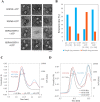HSP60 possesses a GTPase activity and mediates protein folding with HSP10
- PMID: 29208924
- PMCID: PMC5717063
- DOI: 10.1038/s41598-017-17167-7
HSP60 possesses a GTPase activity and mediates protein folding with HSP10
Abstract
The mammalian molecular chaperone, HSP60, plays an essential role in protein homeostasis through mediating protein folding and assembly. The structure and ATP-dependent function of HSP60 has been well established in recent studies. After ATP, GTP is the major cellular nucleotide. In this paper, we have investigated the role of GTP in the activity of HSP60. It was found that HSP60 has different properties with respect to allostery, complex formation and protein folding activity depending on the nucleoside triphosphate present. The presence of GTP slightly affected the ATPase activity of HSP60 during protein folding. These results provide clues as to the functional mechanism of the HSP60-HSP10 complex.
Conflict of interest statement
The authors declare that they have no competing interests.
Figures






References
-
- Hayer-Hartl, M., Bracher, A., Hartl, F.U. The GroEL-GroES Chaperonin Machine: A Nano-Cage for Protein Folding. Trends. Biochem. Sci, 10.1016 (2015). - PubMed
Publication types
MeSH terms
Substances
LinkOut - more resources
Full Text Sources
Other Literature Sources
Research Materials
Miscellaneous

